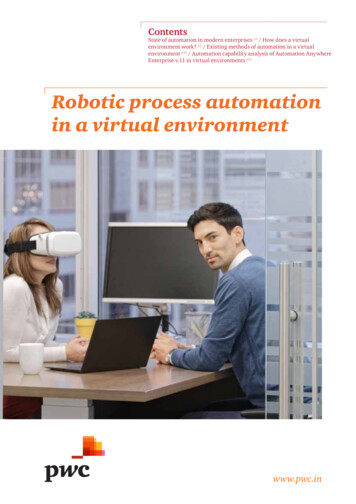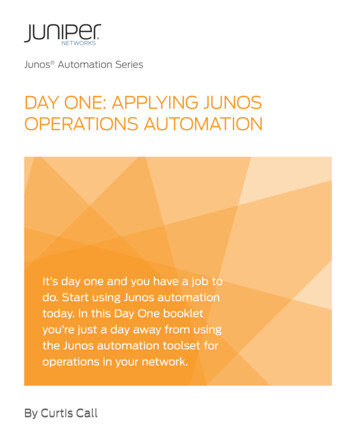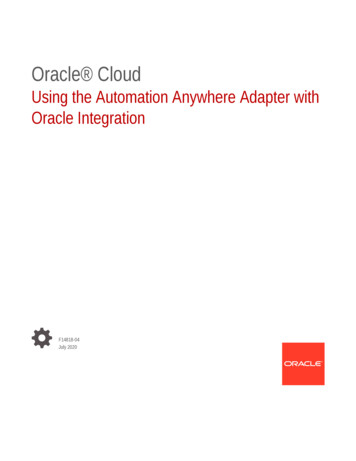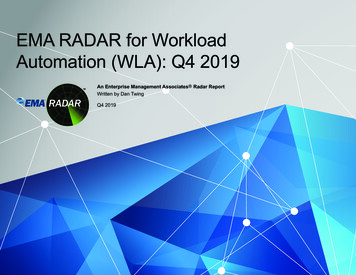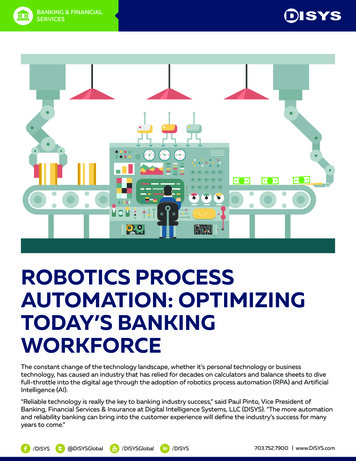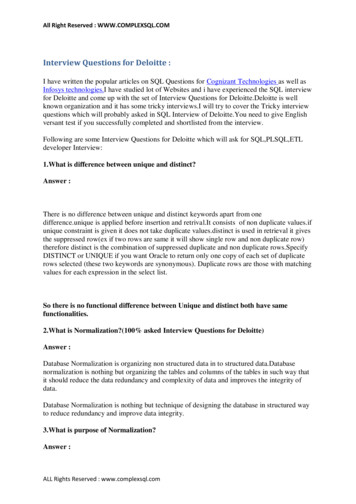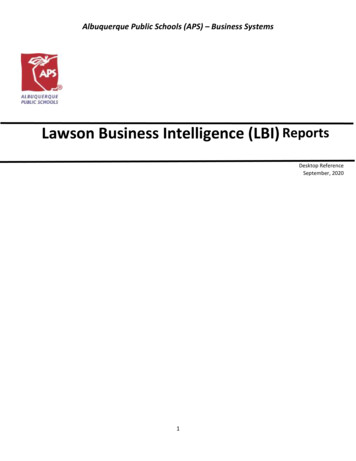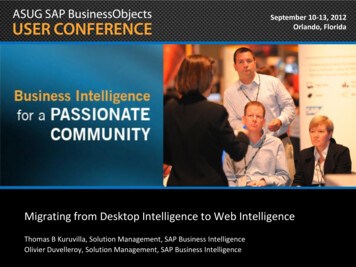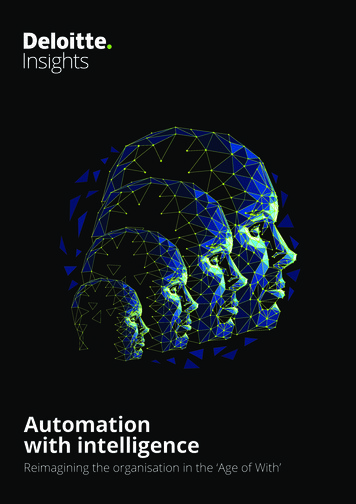
Transcription
Automationwith intelligenceReimagining the organisation in the ‘Age of With’
Deloitte provides a portfolio of services and assets to imagine, deliver and run intelligent automation. Through immersive events we expose and explore opportunities to define the vision,strategy and business case for widespread adoption across the enterprise. We help executivesrefine the design, tools and methods necessary in order to rapidly scale up automation. As thebusiness transformation takes shape and the benefits are realised at scale Deloitte provides botmanagement, maintenance and enhancement.
ContentsIntroduction 2The journey to scale 4The value of intelligent automation 10The Age of With 14Conclusion 21About the authors 22Endnotes 24
Automation with intelligenceIntroductionHumans have misjudged robots. They are often seen as job thieves, threateningworkers with redundancy. Artificial intelligence AI only makes their perceivedthreat worse. Perhaps these thinking machines could, like the fictional robotsof the science-fiction writer, Isaac Asimov, begin to decide humans are superfluous. Our image of the robot, shaped by popular culture, is not a positiveone. Yet, this prejudice should be put aside. Robots, especially thinking ones,are to be welcomed, not feared.MACHINE INTELLIGENCE CAN complementIn May 2019 Deloitte invited executives to take parthuman intelligence. Humans are creative,in an online survey of their intelligent automationimaginative, strategic, tactical and inven-strategies and the impact on their workforces.tive. Robots are better suited to tasks that humansWe received responses from 523 executivesfind difficult and dislike. The inspection of vastin a range of industries in 26 countries acrossamounts of data and search for patterns in that dataAfrica, the Americas, Asia and Europe, with amight involve endless repetition. It would exhaustcombined annual turnover of 2.7 trillion.any human brain, but not a robot one.This opens the way to the future:the Age of With. Robot intelligenceworks with humans to amplify ourintelligence. Helped by robots, we can berelieved of the repetitive and exhaustive,and be free to predict and derive theA combination of human andartificial intelligence implies farreaching change in the structureof our organisations.analytical and strategic. We can create, collabo-The market for automation technologies, suchrate and communicate even more than before.as robotic process automation (RPA), is growingHow work is done, and using which combination 5 billion by 2024.1 Reflecting this growth, respon-of human and artificial intelligence impliesdents to our survey indicated that the number offar-reaching change in the structure of ourorganisations that have successfully scaled theirat 20 per cent per year and is likely to reachautomation implementation has doubled sinceorganisations. How ready are we for this?2018. Eight per cent of executives say that they havedeployed more than 51 automations. Yet achievingscale remains a challenge, with process fragmentation identified as the main barrier to success.2
Automation with intelligenceOrganisations that have achieved scale are thosewith a clear vision, strategy and approach tocapturing value from automation. They haveapproached automation as an enterprisewidechallenge and have established the new capabilitiesrequired. They are more likely to be combiningautomation technologies, and are also much morelikely to be thinking about how automation willassist and augment their workforce and broadenthe scope of work that can be performed.Over the next three years, executives expectautomation to increase their workforce capacityby 27 per cent: equivalent to 2.4 million extra fulltime employees (FTE) in the workforces of the523 organisations that took part in our survey.This presents a significant opportunity to driveproductivity and improve the human experience, as roles are redesigned and work is mademore meaningful. Unfortunately, 44 per cent oforganisations have not yet calculated how theirautomation strategies will affect their workforcewhile 60 per cent have not looked into whetherautomation will require their workers to retrain.Over the next threeyears executives expectautomation to increasetheir workforce capacity by27 per cent: equivalent to2.4 million extra full timeemployees.It is clear that in many organisations, a lot morethought needs to be given to the integration ofhumans and machines and the ways in which theenterprise can be reimagined in the Age of With.3
Automation with intelligenceThe journey to scaleMoving from RPA to intelligent automationIn their embrace of more digitised ways of working, many organisations haveadopted robotics to automate repetitive rules-based processes. They are nowseeking to scale these solutions and make them smarter by integrating artificialAI capabilities.RDEFINITIONSOBOTIC PROCESS AUTOMATION (RPA) canbridge multiple different systems and inter-Robotic process automation: RPA is theautomation of business processes in whichsoftware performs tasks that can be codifiedby computers. It is often referred to as‘robotics’ or ‘robots’, and is defined as theautomation of rules-based processes withsoftware that utilises the user interface andwhich can run on any software, includingWeb-based applications, ERP systems andmainframe systems.faces. RPA uses precisely programmed ‘bots’to automate specific routine tasks, reducing pro-cessing time dramatically and ensuring greaterquality by providing consistent results with negligible errors. In addition, if implemented effectively,RPA can free up the workforce to focus on morestrategic activities or customer-focused tasks.Our analysis reveals that organisations are not onlycontinuing to use RPA, but are moving beyond byArtificial intelligence: AI technologies performtasks that previously required humanintelligence, such as extracting meaning fromimages, text or speech, detecting patterns andanomalies, and making recommendations,predictions or decisions. They includemachine learning, deep learning, naturallanguage processing and generation.seeking to ramp up deployment of intelligentautomation. Fifty-eight per cent of surveyedexecutives report they have started their intelligentautomation journey. Of these, 38 per cent arepiloting (1-10 automations), 12 per cent areimplementing (11-50 automations), and eight percent are automating at scale (51 automations).The number of organisations deploying at scaleIntelligent automation: The combination of RPA,AI and other related automation technologies.has doubled compared to our 2018 findings.RPA can free up theworkforce to focus onmore strategic activities orcustomer-focused tasks.4
Automation with intelligenceBuilding smarter botsExpected benefits ofintelligent automationRPA many has great and obvious benefits, but alsolimitations. Bots can only follow logical rules-With intelligent automation technologies,based processes. They do not see patterns in dataorganisations can transform business processes –or extract meaning from images, text or speech.not only achieving higher speed and precision,The RPA software is programmed to process func-but also automating predictions and decisionstions, such as registration, invoicing or data transfer,on the basis of structured and unstructuredwithout understanding the logic behind them.inputs. Our analysis reveals that three primarybenefits are driving uptake of the technology.Having exhausted many of the low-value oppor-Organisations expect to achieve increasedtunities available through such simple task-basedproductivity and cost reduction; greater accu-automation, organisations are now seeking toracy; and an improved customer experience.implement next-generation solutions. Theseleverage multiple advanced technologies and dataExecutives estimate intelligent automation willscience such as AI to make automations smarterprovide an average cost reduction of 22 per centand to provide more value to the organisation.and an increase in revenue of 11 per cent over thenext three years. However, those organisations cur-Set up in this way, RPA software aggregates andrently scaling intelligent automation say they haveprocesses data under the direction of more ad-already achieved a 27 per cent reduction in costsvanced – or intelligent – technologies. When AIon average from their implementations to date.has completed its functions on the raw data,RPA then pushes the answers to the target systems.FIGURE 1The path to intelligent automation and beyondReimagine automation (AI, some RPA and workforce redesign)Intelligent automation (RPA and some AI)Potential valueHighTask-based automation (RPA)LowEnd-to-endopportunitiesLowUse case targetedopportunitiesNumber of opportunitiesLow-valueopportunitiesHighSource: Deloitte analysis.Deloitte Insights deloitte.com/insights5
Automation with intelligenceForty-seven per cent of organisations have alreadyFurther evidence suggests intelligent automationcombined RPA and AI as part of their intelligentimplementations are exceeding expectations. Organisa-automation strategy. They report higher increasestions piloting intelligent automation expect an averagein revenue to date as a result of their automations,payback period of 15 months; those in the scalingaveraging a rise of nine per cent. Those only usingphase report an average payback after just nine months.RPA report just a three per cent increase in revenue.Based on our past research, Deloitte concludes thatmost organisations are making steady progress inthe application of intelligent automation, thoughmany are thwarted by significant barriers.FIGURE 2Top three expected benefits from intelligent automation adoptionRank 1Rank 2Rank 3Increase productivity73%Cost reduction60%Improve accuracy44%Improve customer experience39%Improve analytics25%Improve employee experience23%We do not have an intelligent automation strategyReduce fraud and avoid finesOther9%4%4%n 302Source: Deloitte analysis.Deloitte Insights deloitte.com/insightsBARRIERS TO INTELLIGENT AUTOMATION ADOPTIONThe top two barriers for organisations at all stages of adoption are reported to be processfragmentation and IT readiness.Process fragmentation, the way daily processes are managed in a wide range of methods at thedesktop level, is felt by 36 per cent of survey respondents to be the biggest barrier. IT readiness,in terms of infrastructure and systems, is considered the biggest barrier by 17 per cent of organisations.Organisations piloting automation also see a lack of vision and ambition for intelligent automationas a key barrier, while speed of implementation becomes much more significant for organisationsimplementing or scaling automation.An emerging key trend is that organisations often lack the talent to, for example, develop Centres ofExcellence. That creates significant demand for third-party vendors, such as system integrators. Deloitteanticipates a shift from building in-house capabilities to buying automation as a service, driven bycontinuing cost pressures (in part driven by digital disruption), transition to cloud technologies, talentshortages and the challenge of managing a rapidly changing product and vendor ecosystem.Accompanying this is a transformation in the role of Centres of Excellence. These are evolving from‘enablers’ of intelligent automation to ‘internal marketplaces’ or ‘exchanges’ for digital assets. Someare even going beyond this to become ‘directors’ of operational improvements powered by intelligentautomation. This is an important trend and is eflected in the creation of open marketplaces by RPAvendors, for example.6
Automation with intelligenceBuilding a winning intelligentautomation strategyIn addition, organisations in the implementing andscaling phases also have a clear and accepted visionand ambition for intelligent automation (71 per cent)Given the returns that intelligent automation offers,and an enterprisewide intelligent automationorganisations seem slow in their implementationstrategy (49 per cent). Organisations that areand scaling. It is clear that significant barriers mustimplementing or scaling intelligent automation arebe tackled before implementation can proceed,also confident that their workforce has the capacitybut Deloitte notes a distinct difference betweenand skills to implement the solution.organisations in the piloting phase and those inthe scaling phase.PAYBACK UNKNOWNA surprisingly large number of organisationsinitiating intelligent automation projects havenot calculated the payback period. Amongorganisations in the pilot phase, over half(54 per cent) have not estimated the paybackperiod. A third of organisations (35 per cent)implementing and scaling solutions have notdone so either.In particular, executives in organisations scalingintelligent automation are more likely to have aclear understanding of how they will capture valuefrom their projects – 78 per cent of them do so.Only 50 per cent of companies piloting solutionsclaim the same.FIGURE 3FIG 03Percentage of organisations agreeing or disagreeing they have a clear understandingof how to capture value from intelligent automationStrongly agreeAgreeDisagreeStrongly disagree4%Piloting (1-10 automations)46%Implementing (11-50 automations)10%Scaling (51 automations)30%Piloting, implementing and scaling9%45%4%62%28%48%49%23%39%3%*Excludes 'We have not yet started our automation journey'Source: Deloitte analysis.n 302Deloitte Insights deloitte.com/insights7
Automation with intelligenceOther aspects that distinguish organisations scalingScaling organisations have also made significantautomation are a highly supportive IT function withefforts to create mature process definitions,the required technology, infrastructure and cyberse-standards and process management, with thecurity in place (see figure 4), as well as agile,standards controlled by a Centre of Excellence.multidisciplinary teams capable of implementingSome 65 per cent of organisations in the imple-automation at pace. There is also strong emphasismenting and scaling phase hold this latteron appropriate governance, project managementproposition to be true, as opposed to onlyand technology.32 per cent in the piloting phase.FIGURE 4FIG 04 of organisations agreeing or disagreeing they have governance,Percentageproject management and technology in placeStrongly agreeAgreePiloting (1-10 automations)Disagree8%Implementing (11-50 automations)18%Scaling (51 automations)30%Piloting, implementing and scaling13%Strongly disagree43%42%6%57%25%48%47%23%36%4%*Excludes 'We have not yet started our automation journey'n 302Source: Deloitte analysis.Deloitte Insights deloitte.com/insights8
Automation with intelligenceSix key factors for intelligentautomation success04. Mature process definitions,standards and processesMature process definitions, standards and pro-Analysis of the survey data reveals a picture ofcesses lead to higher gains in back officeorganisations that are clearly benefiting fromworkforce capacity. Organisations with theseintelligent automation. Such organisations havein place achieve an average increase in backsix distinguishing characteristics:office workforce capacity of 19 per cent compared to 12 per cent among organisations01. Enterprisewide strategy forwhich do not.intelligent automation05. Clear understanding of how toTypically, companies that have an enterprisewide strategy report higher returns in terms ofcapture valueadditional workforce capacity, cost reductionA clear understanding of how to capture valueand an increase in revenues. They reduce costsfrom intelligent automation leads to muchon average by 24 per cent and increase revenuehigher reductions in costs. Executives with aby 8 per cent, whereas organisations withoutclear understanding report their organisationsan enterprisewide strategy reduce costs by 14reduce costs by 21 per cent on average, whileper cent and increase revenue by three per centthose lacking a clear understanding reduceon average.costs by 15 per cent. However, executives whosay they have a clear understanding of how to02. Combining robotic process automationcapture value do not report significantly higherwith AIgains in revenue (six percent compared to fourThis approach appears to be the most powerfulper cent). It is possible that they are not beingfactor helping organisations increase revenue.ambitious enough in their targets to reap theOrganisations combining the two report anfull benefits.increase in revenue by nine per cent on aver06. Radical simplification driven byage, while those that do not increase revenuesby only three per cent on average. Almost halfa need for cost reduction(45 per cent) of organisations scaling automa-Scaling organisations are more likely to agreetion combine RPA and AI, while only 20 perthat the main purpose of their strategy is radi-cent of organisations piloting and 36 per centcal simplification, driven by a need for costof those implementing are doing the same.reduction. Some 73 per cent do so, while only61 per cent of piloting organisations take the03. Technology, infrastructuresame stance.and cybersecurityOrganisations with a supportive IT function,Almost half (45 per cent)of organisations scalingautomation combineRPA and AI.with the required technology, infrastructureand cybersecurity in place, are more effectiveat reducing their costs. On average they reporta 21 per cent reduction in costs compared to13 per cent among organisations that lackthese functions.9
Automation with intelligenceThe value of intelligentautomationMaking machines more humanThe strength of intelligent automation comes to the fore when RPA combineswith AI to enable applications that go beyond the routine to the innovative:from collecting and processing data to analysing and making contextual decisions. However, a significant number of survey respondents (48 per cent) admitto neither thinking about nor implementing an intelligent automation strategythat includes AI yet. Another 36 per cent include AI in their strategy, but notat scale. Only 11 per cent of organisations are currently scaling solutions thatinclude artificial intelligence.LESSONS FROM THE FRONTLINEIntelligent triageTo help address challenges in patient demand management, Deloitte worked with thegastroenterology department at a large hospital in the UK to develop an AI solution to improvethe triage of general practitioner (GP) referrals.The aim was to use AI to unlock the data held in electronic medical records, permitting more efficientprocessing, intelligent analysis and improved decision-making in order to overcome service challenges.Natural language processing (NLP) was used to read incoming GP referrals to the gastroenterology service.The AI solution suggested the most likely triage outcome, urgency status and clinic or diagnostics forreferral. Two RPA solutions were used: one to pull the electronic medical records into the AI and anotherthat actively looked into a Structured Query Language (SQL) database for updates on whether the AI hadmade its decision. If it had, the RPA pulled the decision into the appointment booking system.Deloitte applied a methodology which combined two classification models – ‘AI-I’ to predict theurgency status and ‘AI-II’ to predict the clinical outcome. By splitting the prediction problem in two,the accuracy significantly improved compared to a single model which would predict the triageoutcome in one step.Within the AI modelling, feature engineering was used to convert free text into a machine-readableformat. Then classification was used to make decisions based on the characteristics extracted fromfeature engineering.10
Automation with intelligenceAI Urgency Classifier (AI-I)UrgencycancerUrgentRoutineNo urgency requiredTriageoutcomeAI Clinic Outcome Classifier (AI-II)General GIclinicColonoscopyEndoscopyColonoscopyand endoscopyClinicalrulesOther categoryThe first model ‘reads’ theGP referral letters and foreach, infers the urgencystatus of the patientThe second model predictsthe clinical outcome for thepatient to visit as the nexttreatment step, which couldbe a general clinic or aprocedure testClinical rules areadded as a safetynet to mitigatethe clinical risksby sendingcomplicated casesto be triagedmanually bycliniciansThe feature engineering used Term Frequency – Inverse Document Frequency (TF-IDF).This looked not just for key words but also for how often they appeared in a given documentcompared to the document base as a whole. It automatically learned to map words into a‘vector space’. Each term can then be represented in a numerical form.The baseline classification model used ‘traditional’ machine learning models such as support vectormachine, random forests and k-nearest neighbours. It also used convolutional neural networks (atype of deep neural network model) to look for patterns in word representationsthat identifed the triage outcome of the referral letter.Thanks to the success of clinically-led proof of concept and pilot work, this AI model has now beenapproved by the client clinical risk committee under an appropriate governance and control modelto automate triage of two cohorts of patients, focusing on urgent suspected cancer referrals.11
Automation with intelligenceEarly adopters and positivereturnsOrganisations combining RPA and AI also reporthigher increases in revenue as a result of theirautomations to date, compared to those using RPAOrganisations that are implementing and scalingalone (8.5 per cent versus 2.9 per cent). They alsointelligent automation are more likely to beachieve greater gains in workforce capacity both incombining RPA and AI. Likewise, those thatthe back office and their core business operations.are incorporating AI as part of their intelligentIt is clear that executives believe they derive moreautomation strategy are more likely to report thateconomic benefit and improve their competitive-deployment meets or exceeds their expectations.ness by integrating AI and RPA rather than usingboth in isolation.FIGURE 5Automations combining RPA and AI deliver above expectations more than RPAonly deploymentsSource:Improved customer experienceCombining RPA and AIRPA onlyExceeded expectations26%21%Met expectations52%42%Improved accuracyCombining RPA and AIRPA onlyExceeded expectations35%21%Met expectations61%67%Improved analyticsCombining RPA and AIRPA onlyExceeded expectations16%8%Met expectations52%46%FIGURE 6Organisations are most likely to use machine intelligence, least likely to usecomputer visionAlready implementedWe will implement in the next 3 yearsNo plans to implementPredictive algorithms or othermachine learning-based solutions48%Expert systems/rule‐based systems32%Natural languageprocessing or generation25%Deep learning18%55%27%Computer vision18%45%37%47%5%21%46%15%61%*Excludes ‘Our current focus is RPA or other types of automation technologies’n 142Source: Deloitte analysis.Deloitte Insights deloitte.com/insights12
Automation with intelligenceThe most popular AI solutions currently beingA potential solution is to place more focus on trainingimplemented as part of intelligent automationmanagement and staff. This should lead to betterstrategies are predictive algorithms or machineunderstanding of the technologies, permitting thelearning-based solutions, expert or rule-basedconstruction of use cases and development roadmaps.systems and natural language processing orgeneration (NLP/NLG). Deloitte expects this willDEFINITIONSchange, with deep learning in particular becomingPredictive algorithms or other machinelearning-based solutions: systems thatcan learn from and make decisions andpredictions based on data.more prominent. Some 18 per cent of respondentshave already implemented deep learning and55 per cent are planning to do so.Deep learning: a specific type of machinelearning that uses cascading layers of modelparameters to learn and represent a hierarchyof concepts. Examples include speech andimage recognition.Barriers to AI implementationOrganisations including AI as part of their intelligent automation strategy see the three biggestNatural language processing or generation:systems that help computers analyse orgenerate human language. Examples includeautomated analysis of customer emails orconversational technologies such as chatbots.barriers to implementation as the identificationof appropriate use cases; data issues (for example,privacy or quality); and the availability and capability of talent.Computer vision: analysing digital images orvideos and creating classifications or high-leveldescriptions that can be used for decisionmaking and action.Executives consider that identification of use casesis difficult because the ‘buzzwords’ associated withthe technology are confusing and many of thetechnology definitions seem to overlap. When anExpert systems/rule-based systems: systemsthat represent knowledge as a set of rules(derived from human experts) that say whatto do or decide in different situations.organisation lacks in-house expertise, it can bedifficult to cut through the terminology and shapean idea into a concept that can be delivered.FIGURE 7Use case identification and data issues are the biggest barriers to AI implementationIdentification of appropriate use cases26%Data issues (e.g. privacy or quality)21%Availability and capability of talent14%Cost13%Challenges in measuringand proving business value9%Other6%Information security anddata governance concerns6%Issues working with partners/vendorsLack of communication betweendata scientists and end users4%1%*Excludes ‘Our current focus is RPA or other types of automation technologies’n 142Source: Deloitte analysis.Deloitte Insights deloitte.com/insights13
Automation with intelligenceThe Age of WithHuman-machine systemsArtificial intelligence has now come of age. Deloitte refers to this as the Ageof With: a world where humans are aided and augmented by automation.The power of automation is the power to reimagine the way organisations dothings. But that can only happen when organisations understand the tools AIgives them and are ready to absorb and adopt these technologies.Preparing the workforce forthe impact of automationAMoreover, almost two-thirds of organisationshave not considered what proportion of their workforce needs to retrain as a result of automation.I INCREASES THE productive capacity ofEven organisations that have automated at scalethe human workforce. Over 90 per cent of(51 automations) are not yet thinking about this,organisations surveyed expect it to increasewith 53 per cent stating that they have not yettheir workforce capacity. On average, they expect aexplored whether their workforce needs to reskill26 per cent increase in back office capacity over theas a result of their automation strategy.next three years and a 17 per cent increase in capac-Almost two-thirds oforganisationshave not consideredwhat proportion of theirworkforce needs to retrainas a result of automation.ity in their core business operations. Despite theopportunity presented by intelligent automation toincrease productivity, 44 per cent of organisationshave not yet calculated how their workforce’s rolesand tasks, and the way tasks are performed,will change.14
Automation with intelligenceFIGURE 8Percentage of the workforce that has seen changes to their roles, tasks andways of working as a result of intelligent automation, implementing andscaling respondents44%30%13%8%6%0%We have notcalculated thisNochange0%1-10%11-20%21-30%31-40%41% Percentage of workforce**Excludes ’We have not yet started our automation journey" and ‘We are piloting (1-10 automations)'Source: Deloitte analysis.n 101Deloitte Insights deloitte.com/insightsAccording to survey respondents, on average, 19.5 per cent of workers have seen a change to their rolesor ways of working because of the implementation of intelligent automation.FIGURE 09Percentage of workforce needing to retrain in the next three years as a result ofintelligent automation, piloting, implementing and scaling respondents60%12%8%3%We have notcalculated thisNo 0%41% Percentage of workforcen 302Source: Deloitte analysis.Deloitte Insights deloitte.com/insightsAccording to survey respondents, on average, 29.4 per cent of workers will have to retrain in the nextthree years as a result of the implementation of intelligent automation.15
Automation with intelligenceReimagine with a human focusDeloitte’s Voice of the Workforce in Europe foundthat 65 per cent of workers believe they need toIn many ways technology has leaped ahead ofacquire advanced IT skills to ensure their futureexecutives and organisations, and the humanemployability.3 However, where retraining iselement needs to catch up. As automation becomesoffered, it focuses instead on process skills suchmore prevalent in the workplace, there is a need toas active listening and critical thinking, cognitiveput meaning back into work and an opportunity forabilities such as creativity and problem solving,organisations to address the ‘human experience’.2and system skills like decision-making and systemsanalysis. There is clearly a perception gap betweenReskilling based on how the human workforce willthe skills identified by employers as being critical tointeract with machines, including changes to roletheir newly automated and digitised organisationsdefinitions, should be baked into organisations’and the skills that employees believe they will needplans for intelligent automation adoption in orderin the future.to capitalise on the expected increase in workforceThere is clearly a perceptiongap between the skillsidentified by employers asbeing critical to their newlyautomated and digitisedorganisations and the skillsthat employees believe theywill need in the future.capacity. But 38 per cent of organisations are notyet retraining employees whose roles have changed.Deloitte notes that eve
Moving from RPA to intelligent automation DEFINITIONS Robotic process automation: RPA is the automation of business processes in which software performs tasks that can be codified by computers. It is often referred to as ‘robotics’ or ‘robots’, and is defined as the

